Many brands find themselves at a point where they have achieved some success with their line of products, and they are feeling pressure from investors and business partners to keep growing. The solution seems to be launching more products similar to their successful product.
But 80% of new product launches fail!
Therefore, many brands choose to mitigate that risk by doing a product line extension.
A product line extension is the launch of a new product in a product category where the brand already sells products. The new product sells alongside the existing products. Typically a line extension is a new flavor, scent, formula, color, size, or style of a product in a current product line.
Extending a product line is less risky than launching an entirely new product or performing a brand extension because customers are already familiar with the existing products and are more likely to try the new product. The new product can leverage the same retail partners, supply chains, packaging, and other things that it shares with the old products. Less advertising and communication is required because of the similarity to the old and well-known products.
There is less risk, but there is less potential reward as well. The brand is essentially competing with its old products. There is less opportunity for incremental sales because sales of the new product might come at the expense of the existing products.
Successful Examples of Line Extensions:
- Colgate with Hemp Seed Oil
- Coca-Cola Cinnamon
- Lux White Impress
- Honda Civic Si
- Hellmann’s Mayonaise with Olive Oil
- Mr. Clean Clean Freak
- Nissan Leaf
Disastrous Example of Line Extensions
- Burger King Satisfries
- Crystal Pepsi
We expand on all these examples of line extensions, good and bad, in the rest of the article below. I give the historical, what the company was looking to achieve, and my take on the extension. But first, we go through some basics of brand extensions.
Let’s go!
Product Line Extension Basics
Before we go into the examples of line extensions, let’s make sure we understand what a line extension is and how it differs from a brand extension.
Meaning of Line Extension
A new variant of an existing product that competes in the same category.
A product line extension is when an existing brand launches new products in a product category they already offer products within.
For example, when a soft drink company offers a new flavor of soda. Or when a toothpaste company has a product that focuses on whitening teeth and then provides a toothpaste that reduces tooth sensitivity.
The new product needs to be on the market while the existing products are still offered to be considered a line extension. A new product that replaces an old product in the lineup is regarded as a product update, not a line extension.
Sometimes a line extension is called a product extension. Both terms mean the same thing.
Line Extension vs. Brand Extension
A line extension is within the same category, while a brand extension moves beyond.
As we learned, a line extension is when the same brand puts out a new product in their existing category.
However, a brand extension is when an existing brand offers a new product in a product category the brand has never competed in.
For example, Ferrari is known for its exotic cars. But in 2010, they extended the Ferrari brand into theme parks by opening the Ferrari World in Abu Dhabi. BMB goes in-depth into the Ferrari example and ten others in our article about examples of brand extensions.
The main difference between line extensions and brand extensions is the product category. If the product category is new for the brand, then it is considered a brand extension. But if the category is the same as old products for the brand, then it is merely a line extension.
Line extensions are safer than brand extensions. If a brand shows up in a new product category, then they have to convince potential customers that the new product works and the brand makes sense in the category.
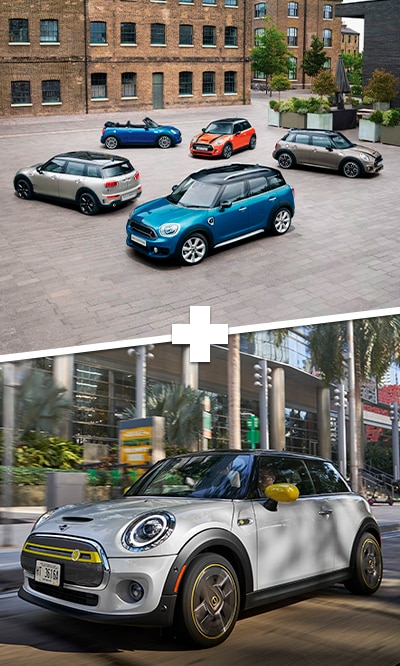
The boundaries between product categories can be blurry. Reasonable minds will differ whether a new product constitutes a line extension or a brand extension. For example, when the BMW Group offers the All-Electric Mini Cooper, are they extending the Cooper product line? Or are electric cars and gas cars completely different categories?
I consider two products to be in the same category if they meet the same need. You could swap one for the other for a customer, and they could accomplish what they were after.
If we swap a bather’s shampoo from a mint-scented one to a lemon-scented one, that wouldn’t be a problem. If you swapped someone’s shampoo for conditioner, then they cannot wash their hair. Shampoo and conditioner are separate product categories.
Line Extension Examples
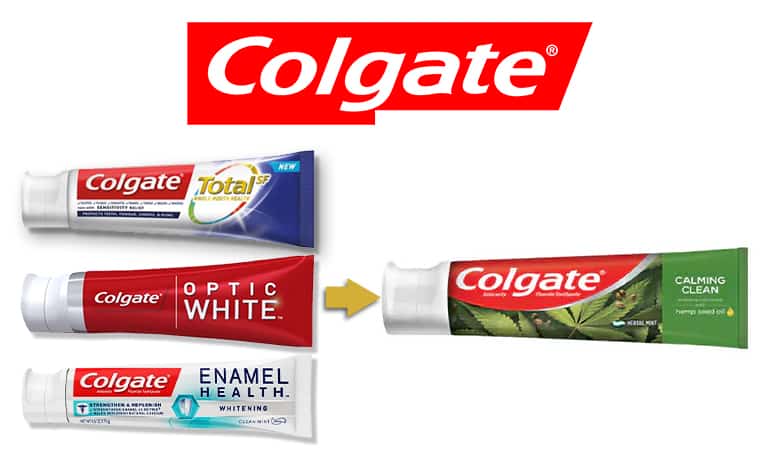
Colgate with Hemp Seed Oil
Colgate-Palmolive extended their line of toothpastes with one that has hemp seed oil.
Original Product Line:
Colgate Cavity Protection, Colgate Total, Colgate Optic White, Colgate Enamel Health, Colgate Max Fresh, Colgate Sensitive Pro-Relief, and more.
Line Extension:
What is different?
Colgate Calming Clean using hemp seed oil as a filler which soothes the mouth during brushing.
I bet you never thought you would see a Cannabis sativa leaf on a tube of Colgate toothpaste. (Am I right? Comment below the article!)
The leaves reference the plant the hemp seed oil found in the toothpaste is derived from. Hemp is a classification of Cannabis plants which have less than 0.3% THC content, or less. THC is the chemical that makes people feel high when they smoke or eat marijuana.
So I hate to break it to you, but you are not going to get high brushing your teeth with this product.
Hemp is an extraordinarily useful plant. Both it’s oil and fibers have excellent technical properties and can be made into many products.
Hemp’s usefulness big part of the founding of America. The settlers of the new world came over on boats with sails made of hemp, and King James decreed that the American colonists in Jamestown were to cultivate and export hemp plants. George Washington grew hemp at Mount Vernon.
But, the US turned on cannabis. Marijuana was demonized in the 1930s with the “reefer madness” campaign and lobbying. As a result, weed became illegal.
In the a classic case of “throwing out the baby with the bathwater,” hemp and it’s usefulness got tossed out too. Even though hemp varieties of cannabis plants can’t be used to “get high,” the scrutiny and the stigma around the plant made it impossible for farmers to grow profitably.
But nothing lasts forever, and cultural views of cannabis have changed nearly a century later. Marijuana is now being legalized in many regions, and many people have a favorable view of hemp.
Colgate purchased Hello Products in February of 2020. Hello produces and sells personal care products with cannabidiol (CBD) and other less-processed / more natural ingredients. Around the same time as the acquisition, Colgate registered a toothpaste with hemp seed oil with the US Food and Drug Association (FDA). That product was launched as ‘Colgate with Hemp Seed Oil’ and is now ‘Colgate: Calming Clean with Help Seed Oil.’
The addition of hemp seed oil makes the toothpaste more soothing and moisturizing to the mouth and gums. This is why Colgate is marketing it under the sub-brand Calming Clean. It soothes and calms people’s mouths who would normally find traditional kinds of toothpaste irritating.
My Take
We’ll see if the market will accept a Colgate toothpaste that associates itself with cannabis, but I am willing to call this one successful based on how well the Hello products are doing.
Hello Products is a very fast-growing brand because of its alignment of values with its customers. Both the company and the customers are willing to experiment with personal care products with interesting and natural ingredients.
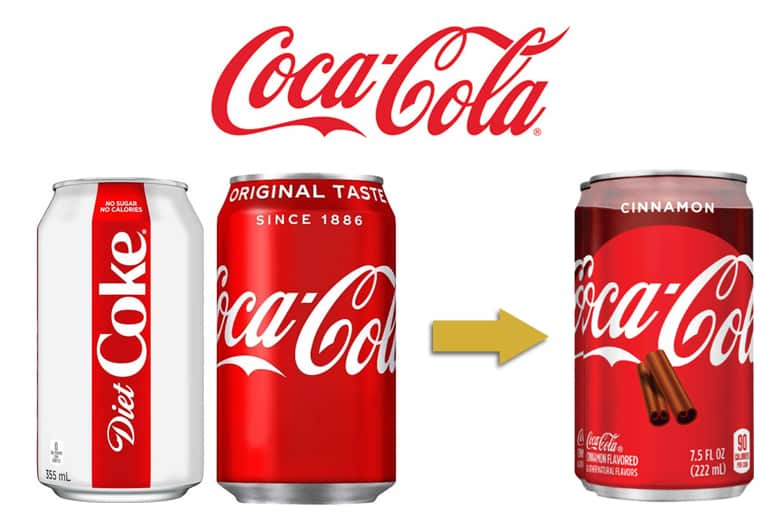
Coca-Cola Cinnamon
Coca-Cola extended their line of soft drinks with a seasonal cinnamon flavored version.
Original Product Line:
Coca-Cola, Diet Coke, Coca-Cola Zero Sugar, Diet Coke XTRA
Line Extension:
Coca-Cola Cinnamon
What is different?
The classic Coke flavor with a hint of cinnamon for the holidays.
Adding a new product brings an element of excitement to the brand. New products also come with media attention in the form of announcements, reviews, and recommendations. Food and beverage brands are poised to leverage the hype from new products because they can make flavor changes relatively easily.
Most line extensions are available indefinitely, or that is what the executive hopes if the product is a success. But limited editions create a sense of fear-of-missing-out in the consumer. The combination of new and limited time only invites customers to try the product, and the products can become a talking point.
Coca-Cola introduced Winter Spiced Cranberry Sprite and Cinnamon Coca-Cola to commemorate the holiday season and build some buzz. Both SKUs (Stock Keeping Units) were available from September 30, 2019, to the new year. Cinnamon Coca-Cola was based on a flavor of Coke Zero, which was offered in England in the holiday season of 2018.
The buzz around Cinnamon Coca-Cola built up slowly and peaked during the holidays, just as Coca-Cola expected.
But Sprite Cranberry surprised everyone. It was slowly ramping up alongside Cinnamon Coke, but then the buzz around it exploded in mid-November. This spike was likely because of the TV commercial “The Thirstiest Time of the Year,” which featured a claymation depiction of Lebron James. This ad became a meme around the internet, and the new product benefitted from the free promotion that came with all the GIFs and social media comments.
So Cinnamon Coca-Cola failed to make the splash that Sprite Cranberry did, but I am sure the product still met the expectations of the people at Coca-Cola. It resulted in some free promotion, it connected Coca-Cola with the holiday season, and I am sure it displaced some competitive products in store for the three months.
My Take:
I am a big advocate of an “innovation SKU” for consumables like food, beverage, and personal care products. The tactic involves the brand putting out four or five standard products with traditional flavors or scents, but having one “slot” for a SKU that defies expectation. That innovation SKU has a taste or fragrance that people will love or hate. Everybody is of the understanding that this product is available for a limited time only.
Having a product slot dedicationed to something exciting is a great way to innovate while still hedging. If the flavor or scent is wildly popular, then it can be folded into the mainline of products; the classic “back by popular demand.” If the product is a flop, then the consumer just goes back to the regular products. It still builds a sense of excitement and innovation around the brand.
Ben and Jerry’s is a brand that uses this tactic. They have an innovation SKU they call a “Limited Batch Flavor.” As of writing this, the flavor is Pucker Upper Sorbet. They also encourage customers to vote on which flavor to bring back; this is akin to our guide to fold the innovation SKU into the main line if it is well-loved.
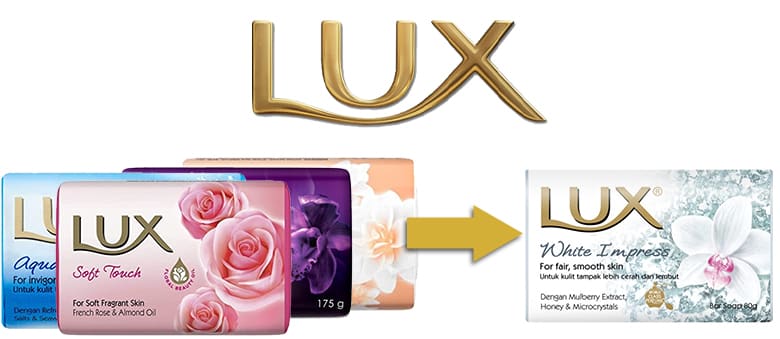
Lux White Impress
Unilever India extended their line of soaps with a promoting lighter skin.
Original Product Line:
Lux Aqua Sparkle, Lux Soft Touch, Lux Magical Spell, Lux Velvet Touch
Line Extension:
Lux White Impress
What is different?
A skin soap with exfoliants and whiteners for people who value having fairer skin.
Indian culture values light skin. Some of the people of India, and citizens other countries around the world, want to have lighter skin because they feel that people look more favorably on them, especially when they are candidates for a job or marriage. Film and television executives actively cast light-skinned Indian men and women as the protagonists, especially if there is a romantic element to the story.
The cultural preference results in India’s people wanting to make sure they are doing what they can to maintain the lightness of their skin or even lighten their skin from its natural tone. There is a demand for skin whitening personal care products such as soap and creams.
Lux soap is one of the oldest brands owned by Unilever; Lux was one of the brands started by the Lever brothers in 1925 (yes, “Lever” as in Uni-LEVER.) The brand started in the United States, quickly grew into the United Kingdom, and then went worldwide since them. The soap has been marketed as a premium, feminine soap for a century, and has built brand associations to France, movie-stars, and glamour.
Both Lux soap and light skin are tied to glamour and Bollywood, so a skin-whitening soap was a natural line extension for the Lux line of soaps. Unilever launched the product a decade ago. Lux White Impress can be purchased as both bar soap, and a body wash. White Impress is the only Lux soap to promise skin lightening; some products like Lux Creamy Perfection offer moisturizers, but most variants, like Hypnotic Rose or Iconic Iris, simply have different scents.
The biggest market for Lux White Impress is India, but the soap is distributed and marketed all over South-East Asia and beyond.
Unilever is aware that the presence and advertising of their products, such as Lux White Impress and Fair & Lovely, have contributed to discrimination against darker-skinned people and a loss of self-worth. TV spots have historically featured women struggling to impress people until they use the products, flaunt their dramatically lighter skin, and get the job or proposal they were seeking. The advertising leaves darker-skinned people to feel they are less deserving of desirable things in life, and some feel they have to use skin lightening products to get married or advance in their careers.
Unilever has vowed to be more inclusive moving forward, and promise not to make claims comparing skin before and after use, as well stopping the use of terms like ‘fair/fairness’, ‘white/whitening’, and ‘light/lightening’ in their marketing. The promise means a rebranding of Fair & Lovely because “fair” is in the brand name, which will be a significant financial hit for Unilever as it is the leading brand in many markets.
You may ask: why not just pull the products as a moral stand? If the market still demands such products, then their absence may leave people turning to unsafe products and unlicensed procedures, as has happened in Bangladesh, where the government has banned such products. Both the culture and the brands have to change together.
My Take:
I am Canadian, and not part of the Indian culture, so won’t comment on the culture’s desire for lighter skin.
Here in North America, there are many products to change our appearance: hair color, tanning sprays, even breast augmentation. I hope the people of Canada use these products to express themselves, rather than feeling compelled to, but I am sure it is a bit of both.
I am glad Unilever is taking steps to improve their marketing so that people aren’t left hating their natural appearance, but I do no condemn them for providing products that were demanded by the market.
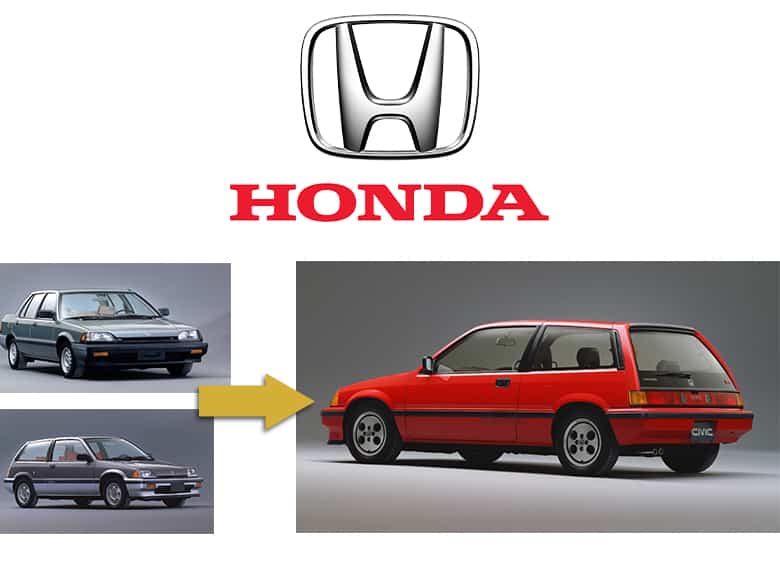
Honda Civic Si
Honda extended their line of compact cars with an sport hatchback.
Original Product Line:
Honda Civic DX, Honda Civic CRX
Line Extension:
Honda Civic Si
What is different?
A Honda Civic hatchback with a powerful, high revving, and fun-to-drive DOHC engine.
Honda introduced the Civic in the United States as a bare-bones, get for A to B cheaply and reliably. They advertised under the tag line: “We Make It Simple.” To put the bare-bones nature in perspective, the GL “luxury: trim level came with a tachometer, a clock, and padded seats. Ooooo… fancy!
Despite being basically four wheels and some seats, the bare bones Civis of the 1980s were fun to drive. Their high revving engines made you feel like you were a rally driver, even if you were just riding around town. Honda introduced the Civic S in 1983 with sport suspension, wheels, and tires. But the S version didn’t capture the excitement that the competitive Volkswagen GTI was, so Honda dropped the trim level after just one year.
The first Honda Civic Si was only available in Japan, but was the first Honda to come with a DOHC (Dual Overhead Cam) motor, a sportier type of small engine now standard in the industry but generally associated with Honda. The Si stood for Sport Injection. The hatchback with the hot engine had a top speed of 122 mph.
The Si first came to the United States only on the Civic CRX body style; the CRX was a sports coupe that was both more aerodynamic for fuel savings, and more like a sports car than the four-seater Civics.
In 1988, the CRX Si was overhauled and upgraded. The refreshed Civic featured suspension, and an engine was futuristic for the time. This Civic Si was the first to receive a VTEC (Variable Valve Timing & Lift Electronic Control), an innovative way to program DOHC motors to rev to an even higher redline.
Honda was also gaining credibility and brand associations with sportiness through its partnership with McLaren to compete in Formula One. “[Honda and McLaren was] one of the most successful partnerships in recent Formula One history. Of the 80 races between 1988 and 1992, McLaren Hondas won 44 of them.” (Bleacher Report) Their success in Formula one directly benefitted the Honda Civic Si and the reputation it has today.
Honda later put out the Civic Type R. This was a Civic designed for the track, with a large, sport-tuned engine and a reduced curb weight. But it was only available in Japan, which left American Honda enthusiasts to modify and swap engines into the sportiest models available, which was the Si. The Civic Si was essential to the 90s tuner scene depicted in The Fast and the Furious movie.
The Si trim level endured through the years, and predictably gave the Civic of the time a high revving engine, manual transmission, and upgraded brakes and suspension. It is the model people seek if they want the comforts and presentability of a compact sedan, but want a little excitement in their lives too.
My Take:
Honda’s introduction and management of the Si trim level in the Civic product line have envigorated the brand. The Honda brand has benefitted from a reputation of being fun-to-drive and a brand association with racing.
There were three parallel processes that earned them that reputation:
- The Civic Si
- The Honda-McLaren F1 racing
- The underground tuner scene
I am sure Honda would prefer their car not to be involved in illegal street racing, but it was an important piece of history that associated the brand with racing, just as their F1 racing did.
Whether someone comes into a Honda dealership interested in a sports model or not, they feel better about the brand because it has that excitement.
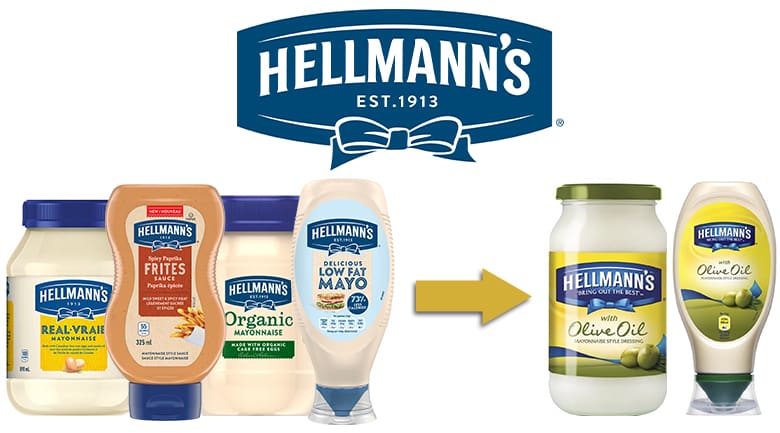
Hellmann’s / Best Foods Mayonaise with Olive Oil
Unilever extended their line of mayonnaise style sauces with one that contains olive oil.
Original Product Line:
Hellmann’s Real Mayonnaise, Hellmann’s 1/2 The Fat Mayonnaise Dressing, Hellmann’s Extra Creamy Mayonnaise
Line Extension:
Hellmann’s Mayonnaise with Olive Oil
What is different?
A mayonnaise in which some of the soy bean oil is substituted for olive oil.
The main reason brands have to launch line extensions is because the market is always changing. A gradual change in the North-American food market is a higher sensitivity to ingredients and health effects from consumers. Grocery store shoppers are now looking for simple, recognizable, and understandable words in the ingredients label.
‘Olive oil’ is not the trademark of any company, but it has it’s own brand, and that brand is on the rise. Celebrity chefs like Rachel Ray have been promoting the health benefits of extra-virgin olive oil for years. As a result, customers feel favorably about products that feature olive oil as an ingredient and are more likely to choose those products over alternatives without olive oil.
Unilever owns the Hellmann’s and Best Food brands. The sauce products are sold as Hellmann’s in central and eastern US and Canada, and Best Foods on the west coast. The product formulations are the same.
In 2015, Unilever responded to the market preference for healthy and simple ingredients by replacing some of the soybean oil in their standard mayonnaise with olive oil and marketing it as a new product. They benefitted from the rising popularity of olive oil. The variant also leaves less space on grocery store shelves for competing products.
“The product launches at a time when consumers are looking for products with a healthier positioning and seeks to reinvigorate the £146 million mayonnaise market by offering consumers a new product proposition from an iconic brand” a Unilever representative told FoodBev Media in 2015.
My Take:
What fascinates me about branding is that the market can naturally develop a preference for unowned and unmanaged brands like ‘olive oil.’ A brand manager or public relations professional could not have managed the ‘olive oil’ brand any better than it has evolved naturally; influencers have endorsed and promoted the use of olive oil. Now, brands are spending money to market their products that feature olive oil.
Olive oil has some legitimate health benefits over other oils, but it has now achieved a sacred status; any food dish that contains olive oil is assumed to be better.
Unilever was smart to cash in on the hype around olive oil. They did this with the Hellmann’s / Best Foods mayonnaise as well as the Becel spreads and others.
Off-topic note: olive oil is better in many ways to other oils, but only for room temperature uses. Please do not use it for frying. It has a relatively low smoking point of 410 degrees Fahrenheit, meaning it can be bad for you if heated up beyond that temperature. Other vegetable oils are better for frying.
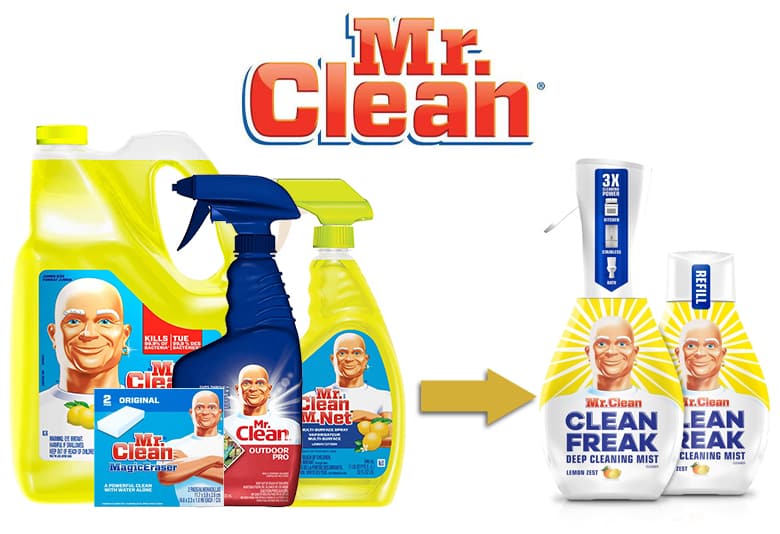
Mr. Clean Clean Freak
Proctor & Gamble extended their line of spray cleaners with a new technology.
Original Product Line:
Mr. Clean All Purpose Cleaner, Mr. Clean Multi Surface Cleaner, Mr. Clean All Purpose Antibacterial Cleaner
Line Extension:
Mr. Clean Clean Freak Multi-Surface Spray (Lemon Zest), … (Lavender), … (Spring Fresh)
What is different?
The new bottle design can be used at any angle and with a light touch thanks to replaceable canisters.
Mr. Clean is owned and managed by Proctor & Gamble. We’ve covered Mr. Clean before in our examples of umbrella brands. P&G has an extensive portfolio of cleaning solutions under the Mr. Clean brand as well as a licensed line of hard products such as brushes, mops, and toilet bowl cleaners. They have had great success with innovative products such as Mr. Clean Magic Eraser and Sheets.
Mr. Clean: Clean Freak Mist is the first new product that competes with their core product: multi-surface cleaning spray. We are all familiar with the spray bottles, which use the mechanical action of squeezing the trigger to propel a fan of droplets onto a surface. Those spray bottles are used for many products, not just by Mr. Clean or for cleaning products. They are trying to innovate on those crummy but ubiquitous bottles.
The Clean Freak Mist bottle doesn’t require the constant pumping of your hand that a traditional spray bottle does. The bottle has a built-in propellant, so you just hold down the trigger, and it sprays a consistent stream. The bottle also doesn’t require to be straight up and down like a standard spray bottle; the Clean Freak Mist bottle can be shot sideways or even completely upside down.
Not having to have the cleaning solution travel through a plastic stray and pump made for pennies has allowed the chemical engineers to reformulate. Clean Freak Mist is foaming, doesn’t run down a wall, and always multi-surface. Traditional cleaners had variants for kitchen, bathroom, stainless steel, and more. Clean Freak Mist can be used all around the house.
The Mr. Clean: Clean Freak Mist concept was developed at P&G’s Beckett Ridge Technical Center under the leadership of Kathy Fish, Chief Research, Development, and Innovation Officer. That facility is filled with small teams trying to “take down” P&G’s core business practices, much like a start-up would. Proctor and Gamble want to innovate on their entrenched lines pf business before an outside player forces them to.
“We invested in design within the R&D organization to help make sure that we are really crafting holistic experiences from the very beginning,” Fish told Packaging World. “We’re now able to rapidly prototype, test things out very quickly with consumers, and make a decision.”
All of P&G’s innovations like Clean Freak Mist need to work at the levels of product, packaging, brand communication, retail execution, and value.
Let’s break that down for Clean Freak Mist:
- Product: The new formulation is more potent, multi-surface, and sticks to surfaces.
- Packaging: The bottle with the propellant can be used upside down and is easier on the customer’s hands.
- Brand Communications: The innovations are easy to communicate and demonstrate, and the Clean Freak sub-brand fits into the Mr. Clean brand narrative.
- Retail Execution: Clean Freak Mist is sold alongside Mr. Clean products with traditional spray bottles as they transition customers over. The packaging has as much or more space for branding, and the graphic design pops from the store shelves.
- Value: The customer can buy refills, so they do not need to repurchase the sprayer, resulting in a higher initial investment but savings over time.
P&G requires all of these to work together. An idea that is great for one level of execution but diminishes the other would not be greenlit. For example, if the bottle design (packaging) of Clean Freak Mist meant that the bottle had less space for graphics (brand communication / retail execution), then the project would have been halted until that was addressed.
Mr. Clean: Clean Freak Mist is an innovative product. It is something you would expect from an incumbent, a start-up. But P&G is willing to compete with their legacy business models with new and innovative products like Clean Freak Mist.
My Take:
I am glad to hear about the approach and culture of the Beckett Ridge Technical Center. Many big companies rest on the laurels.
Kate Fish even admitted that the brand value of the P&G brands would be enough to float the business even without the innovation:
“And what became clear is that those successful brands weren’t just better than the competition, they were irresistibly superior. They were so superior that they made an emotional connection with consumers, to the point that consumers really missed having that brand in their lives if they switched to another brand.”
But they, and every legacy business, should recognize: if you are not willing to innovate and consume your classic, cushy business model with innovation, then some other company will gladly do it for you.
You should consider using P&G’s levels of execution (product, packaging, brand communication, retail execution, and value) when evaluating your new products.
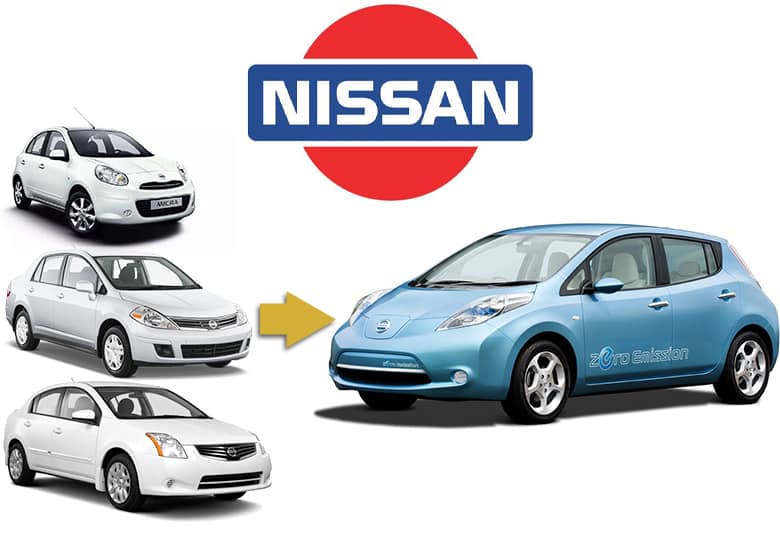
Nissan Leaf
Nissan extended their line of compact cars with an electric car.
Original Product Line:
Nissan Micra, Nissan Versa, Nissan Sentra, Nissan Altima, Nissan Maxima
Line Extension:
Nissan Leaf
What is different?
The Nissan Leaf features an electric motor instead of an internal combustion engine.
The Nissan LEAF is a battery electric vehicle (BEV) that dominated the market for a decade. The LEAF extended Nissan’s line of consumer cars, but ditched the internal combustion engine for an electric motor, and the gas tank for a lithium-ion battery pack. While Tesla was figuring out how to build EVs at scale, Nissan was supplying the globe.
To many, the idea of Nissan building an electric car may have seemed like it came out of left field, but the company has been experimenting with electric propulsion since 1946, starting with the Tama Electric Vehicle. In 1997, Nissan experimented with the Altra, a sizeable electric wagon or van, but it only sold a few hundred in Japan and the United States. In the same year, Nissan released the Hypermini, which was a tiny commuter car for the urban market in Japan.
A decade ago, in 1990, Nissan first offered the LEAF. The LEAF was upgraded every year it has been in the market, and Nissan completely revamped the LEAF in 2017. The LEAF became the best selling plug-in electric vehicle through 2019 but was recently surpassed in 2020 by the Tesla Model 3.
The original design of the LEAF (2010-2016) was similar to the Nissan Versa, but these were completely different cars. The first LEAF was designed to be aerodynamic with a wedge shape that slit the air and bulging headlights that deflected the air flowing over them off the side view mirrors, a significant source of drag in most cars. The first generation LEAF also featured panels on the bottom of the vehicle to reduce drag.
The second generation and current generation of the LEAF (2017 to present) was a far more conventional-looking car and brought the visual language from other Nissan models so that the LEAF didn’t look so obscure.
The second generation was mechanically similar to the first but brought technical features like a lane-centering system and automatic parking. The second-generation LEAF gave drivers the option of one-pedal driving. In this love-it-or-hate-it mode, the regenerative braking can bring the car to a stop by merely lifting off the gas pedal, taking away the need to use the brake pedal except in emergencies.
Nissan is building its Zero Emission sub-brand. Zero Emission is the technology branding that Nissan used to differentiate the LEAF from the popular Toyota Prius, a more efficient car, but still emitted CO2 and other pollutants that the LEAF does not.
Now Nissan seems to be preparing the Zero Emissions brand to encompass more vehicles than the Leaf. History is yet to be written.
My Take:
I drive a plug-in hybrid, so I am entirely ready for the proliferation of EVs.
I was aware that the Nissan LEAF was popular because they are ubiquitous amongst the cars plugged into the public charging ports. But I had no idea that it was the market leader until the Tesla Model 3 ramped up production.
Nissan was silent about the LEAF for so long; they did not advertise the LEAF, instead opting to let people who wanted to take advantage of the government subsidies come to them. While this was a prudent and cost-effective move, I wonder if Nissan would be considered more eco-friendly and have more credibility in the EV space if they had advertised like Toyota did with the Prius and Chevrolet did with the Volt.
Now, people seem to want Tesla’s first, and if the availability or price isn’t acceptable for them, then they look to BMW, Nissan, Hyundai, or Chevrolet.
I wonder if one of the traditional automakers could have been the ‘cool and futuristic’ EV company, or if it needed to be an outsider like Tesla. What do you think? Comment below.
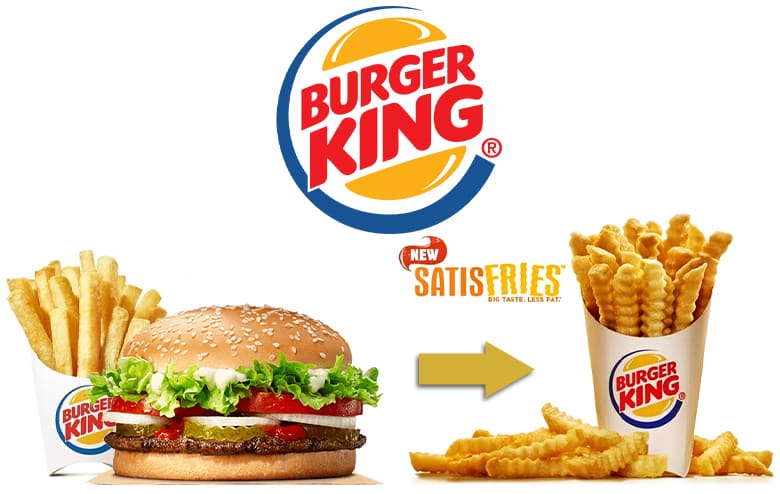
Burger King Satisfries
Burger King extended their line of french fries with ones with less fat.
Original Product Line:
French Fries
Line Extension:
Burger King Satisfries
What is different?
The new fries featured a less porous batter that absorbed less oil.
Fast food restaurants are often criticized for their high-calorie, high-fat and salty options. French fries are the default side dish at most fast food places and are more than half the reason that fast food is unhealthy.
Burger King tried to do something about it. There introduced the Satisfries in 2013 as a line extension. The new fries were to be sold alongside the existing fries; customers could “updgrade” their fries to Satisfries as they were more expensive.
Satisfries used a different formulation of batter, which turned out less porous and thus absorbed less of the cooking oil while cooking in the deep fryer. The resulting fries had fewer calories and less fat than their traditional fries.
The new product was a failure, and they were removed from the menu less than a year after launch. Burger King failed to explain the advantage of Satisfries, so customers wondered why they would pay more for french fries with a different name. Health-conscious diners would order a side salad rather than the ‘less-bad for you’ french fries.
My Take:
Burger King could have communicated the advantages of Satisfries better, but it wasn’t their biggest mistake.
The confusion over the benefits of Satisfries should have been self-evident if the company was in touch with their customers and regularly soliciting their feedback. A survey or a focus group (or just getting out of the office and chatting with customers in line or waiting for their food) would have highlighted the confusion for executives.
It is easy for people from head-office or franchisees to assume everyone knows what Satisfries are because they have been talking about it internally for months; meanwhile, front-line staff and customers are left in the dark.
But the real mistake was not replacing the regular menu fries with Satisfries. If making their menu more healthy was a real value for Burger King leaders, then they should have stood by the courage of their convictions and replaced the unhealthy fries with “new, improved, and healthier fries” even if it would increase prices or reduce profits. They could have tested this approach in select stores and measured the results if they wanted to reduce the risk.
By having two different types of fries, not only are you complicating the restaurants’ operation, but you are confusing the buying process for the customer. Customers will freeze when they are presented with too many options, and it will result in a poor experience and go elsewhere next time.
I don’t blame Burger King executives; this is probably a failing of the franchise model. Franchise businesses have trouble rolling out product changes because the franchisees push back. This is in stark contrast to corporate-owned stores, like Starbucks, which have far more control over their operations.
Franchisees and people from the head office have a tough relationship. The franchisees are both investors, licensors, and customers of corporate. They have a lot of their money invested in the store and are risk-averse.
I would speculate that Burger King’s head office wanted to replace the standard fries with a new recipe and sell at a decreased margin, and the franchisees pushed back. As a compromise, they introduced Satisfries alongside the regular fries, and franchisees did not train staff to promote the Satisfries because they didn’t want them to succeed and replace the original fries.
Just my educated guess! I consulted for a franchised national pizza restaurant, and we had to market the menu changes as much to franchisees as to end customers. It was challenging.
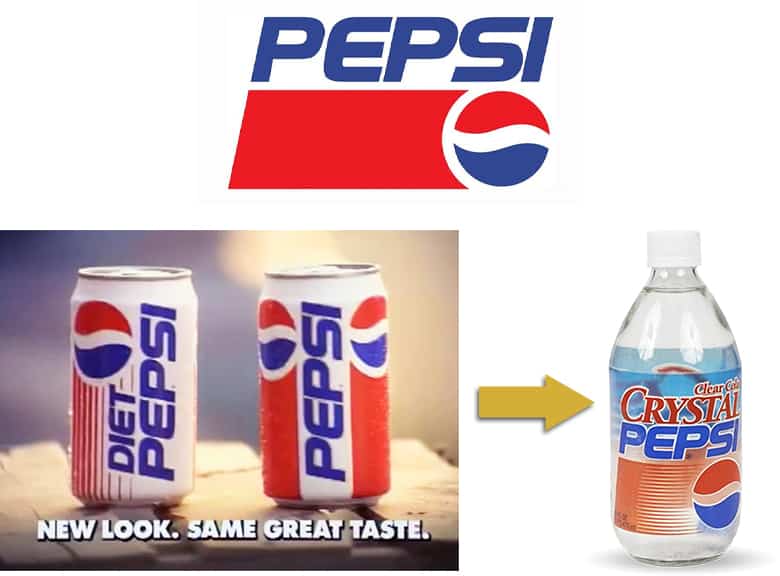
Crystal Pepsi
Pepsico extended their line of soft drinks with a clear version.
Original Product Line:
Pepsi, Diet Pepsi
Line Extension:
Crystal Pepsi
What is different?
A clear, more natural Pepsi with the classic flavor.
History
Crystal Pepsi was a new formulation introduced in 1992 as a line extension to the existing Pepsi and Diet Pepsi. The taste was similar to classic Pepsi, but the drink was clear and caffeine-free. It was marketed as a “pure” and “natural” alternative to traditional colas. The new descriptors would help the Pepsi brand because it suffered from negative brand associations and was considered “artificial” and “chemical.”
Crystal Pepsi is now a meme in marketing circles representing how horribly a product can fail and how out of touch it looks. But Crystal Pepsi did not start as a failure; the idea resonated with the market, and it successfully launched. But shortcuts taken in product development came back to haunt Pepsi, and many people who tried Crystal Pepsi never came back for a second bottle.
“It was probably the best idea I’ve ever had — and the most poorly executed,” said David Novak, the marketing executive behind Crystal Pepsi.
Executives at Pepsi were committed to packaging the product in a clear bottle despite the warnings from their food scientists. The clear bottle ultimately made the drink spoil in direct sunlight, much to the disgust of the customer who tried to drink it.
Coca-Cola also launched a product, Tab Clear, with the sole purpose of confusing the buyers of Crystal Pepsi. Coke’s product was a diet soda with artificial sweeteners, which cut right against Crystal Pepsi’s brand image of being natural. The market was confused, and both products failed.
“Pepsi spent an enormous amount of money on the brand and, regardless, we killed it,” said former Coca-Cola executive Sergio Zyma noted in the book, Killing Giants: 10 Strategies to Topple the Goliath in Your Industry. (Buy the boom on Barnes and Noble or Amazon.)
To read a great deep dive into the early success and eventual failure of Crystal Pepsi, check out Thrillist’s: “How Crystal Pepsi Became the Soda World’s Greatest Fail.”
My Take
Crystal Pepsi could have been a success, and we could still have it on the shelves today. What kept it from success was the attachment Pepsi executives had to their original idea, rather than iterating on it.
The clear bottle was not an essential part of the idea. When a legendary food scientist like Surinder Kumar tells you that it needs to be bottled in cans or colored bottles, you listen. You acknowledge reality and understand that you are going to have to promote the idea of it being clear rather than relying on the bottle to do that for you.
Conclusion. The question with line extensions is always: Why?
If you are to introduce a new variant of your existing product, both you and the customer better know why.

If a company is considering extended their existing product line, then we can safely assume that it is doing well. Therefore, one of my favorite adages applies: “Don’t mess with success.”
Introducing a new alternative to the existing product begs the question: what was wrong with the original product? The brands that have the most robust meaning (Coca-Cola, Apple, etc.) have resisted the urge to introduce meaningless line extensions.
Most line extensions start with invalid reasons.
Many brands introduce variations just to monopolize store shelf space. Ever wonder why there are so many variations of something as simple as peanut butter? Because every one of those SKUs takes up a space that a competitor can no longer take.
The second most common reason is purely a human failing. Marketing executives and product managers develop and launch products as something to do. A new product launch is an easy way to fake progress to executives, and a product launch comes with clear deliverables and timelines. It is easy to come up with things to do when launching a new product vs. the challenge of thinking of ways to expand the market share of an existing product.
But there are justifiable line extensions. Technology and tastes can change, and a product variant can better position a brand for success.
If a company has developed a new technology to solve an old problem, it makes sense to launch a new product alongside the old product and then transition the long-time users to the latest tech.
As we discussed, Mr. Clean Clean Freak Mist is a superior way to spray and clean, but it would be inappropriate to pull the classic Mr. Clean spray cleaner that everyone knows and is familiar with using. The best Proctor & Gamble (owners of the Mr. Clean brand) can hope for us to move people over to Clean Freak over time. The same can be said of Nissan with their push into electric vehicles.
The tastes and values of the people of the market can also change.
Most of the food and beverage line extensions we discussed (Hellmann’s Olive Oil, Cristal Pepsi, and Burger King Satisfries) all were responses to the trend towards health and ingredient-conscious eating. Unfortunately, line extensions based on health make your existing products seem unhealthy.
Launching a new product in an existing line is reasonable if there is a strong reason.
- Why is this product competing with the old product?
- Is the old product inferior?
- Why now?
It is essential that product developers and marketers compellingly answer all these questions for the executives and the people who will buy the new product.
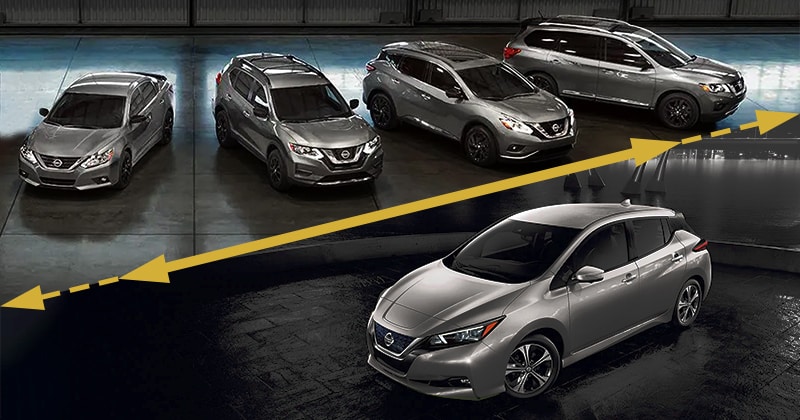
Leave a Reply